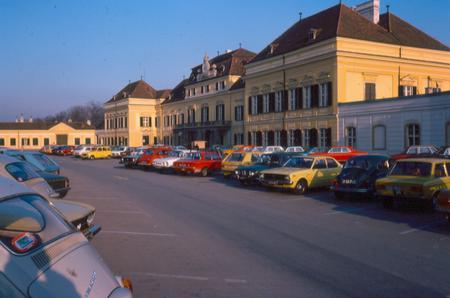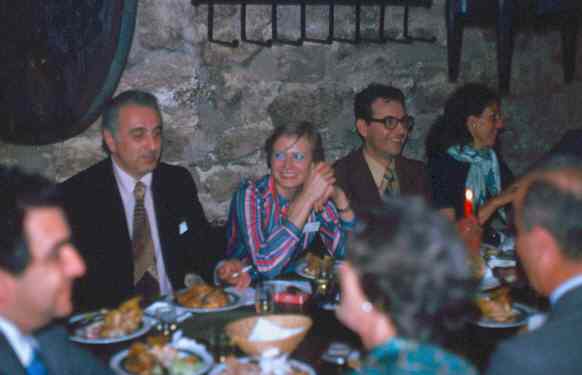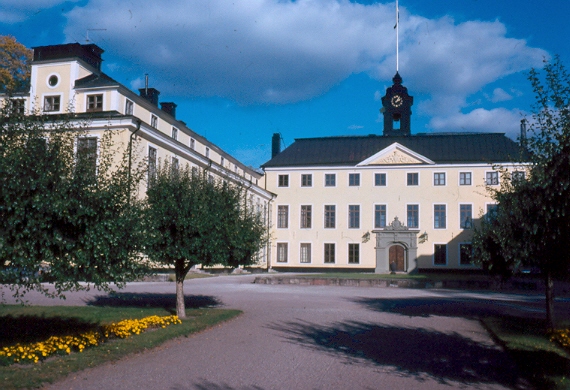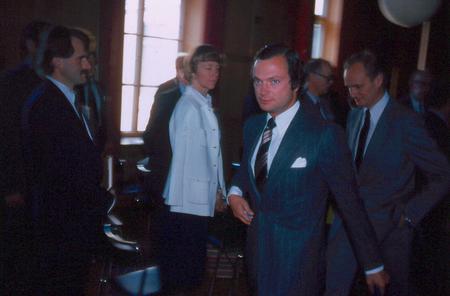Memoirs of a Boffin
Chapter 14: IIASA, IFIAS, CACOR and FIT
From the beginning of the Club of Rome, Aurelio Peccei had encouraged the development of parallel national, regional and local organizations with similar aims and having a loose, independent relationship with the Club of Rome itself and with each other. Canada and Japan were two of the first countries to create such “Associations for the Club of Rome” and were also, quite naturally among the first countries to host full meetings of the Club of Rome (Canada in 1971 and Japan in 1972).
The Canadian Association for the Club of Rome existed informally in the early ’70s but was not incorporated until 1974. It was formally created at an “organizational meeting” on 2-3 May, 1974. The following are extracts from the Proceedings of that meeting:
At the invitation of Canadian Members of the Club of Rome, a group of interested individuals assembled at the Airport Hotel, Toronto, Ontario on 2-3 May, 1974, where it was decided to form the Canadian Association for the Club of Rome.
The six Canadian Members [Dr, Pierre R. Gendron, Senator Maurice Lamontagne, Mr. Ronald S Ritchie, Mr. William Stadelman, Dr. J. Rennie Whitehead, Dr. Robert, J. Uffen] of the Club of Rome (C of R) considered that an association for the Club of Rome should be formed in Canada......... Discussions led to the decision to call a meeting of interested individuals for the purpose of forming a Canadian Association for the Club of Rome The program for this meeting was arranged by Dr. J. Rennie Whitehead and administrative arrangements were carried out by Mr. William Stadelman for a meeting to be held in the Airport Hilton Hotel, Toronto, on 2-3 May, 1974. Dr. Aurelio Peccei and Dr. Alexander King, Members of the Executive Committee of the Club of Rome were invited to attend.
The meeting convened at 0930 hours under the Chairmanship of Dr. J. Rennie Whitehead who, in his opening remarks, read a letter from the Prime Minister expressing best wishes for the success of the meeting.
Aurelio Peccei and Alex King spoke to the meeting at length, describing the objectives of the Club of Rome, welcoming the Canadian initiative and pledging their support. Papers were also presented by Prof. Kimon Valaskakis, Dr. Y.G. Bajard, Prof F. Eric Burke, Mr. W.H.C. Simmonds, Prof Leon Katz, Dr. G.R. Lindsey, Mr. J. Miedzinski, Mr. John Profit and Mr. David Spurgeon. 57 people attended the meeting.
The Directors who were elected at the business meeting which followed were:
- Dr. Pierre Gendron, Chairman
- Mr. Robert Fowler, Vice-Chairman
- Hon. Maurice Lamontagne
- The Rt. Hon Roland Michener, Vice-Chairman
- Mr. Ronald S. Ritchie
- Dr. William Stadelman
- Dr. Robert J. Uffen, Secretary-Treasurer
- Dr. J. Rennie Whitehead.
Since that time, Associations have been established in about 28 countries, including Russia and Ukraine. Many have been active in holding conferences, sponsoring projects and publications and, in some cases, cooperating with activities in other countries.
The Canadian Association for the Club of Rome catalyzed the funding by the Canadian Government of the Montebello Meeting of the Club of Rome at which the Meadows’ Limits to Growth [1] proposals were presented; also the financing of the travel of world experts in the course of the preparation of Beyond the Age of Waste [2], and a South American study Catastrophe or New Society - A Latin American Model [3] which was ultimately published by the International Development Research Centre. In addition to these examples, following the report Global-2000 to the President of the United States, the Canadian Association sponsored the publication of Global-2000 – Implications for Canada [4]. The studies behind these Canadian publications were mostly funded directly by the Canadian Government but the initiative for them came from the Canadian Association for the Club of Rome.
1. The Limits to Growth: by Meadows. Universe Books, (1972)
2. Beyond the Age of Waste: by Gabor, Colombo, King and Galli
3. Catastrophe or New Society - A Latin American Model, IDRC Ottawa (1976)
4. Global-2000 - Implications for Canada. Barney et al, Pergamon, (1980)
It has been the tradition of the Canadian Association to hold an Annual Conference on a topical theme which is frequently chosen to set Canadian issues in a global context. It has usually been combined with the Annual General Meeting that is required by statute. Unfortunately there has been a steady decline in the institutional support of long-distance travel and the Association has become more and more centred on the Ottawa-Montreal-Toronto triangle and even on Ottawa itself. However the Association Luncheon Meetings which are held in Ottawa several times a year have been increasingly successful, thanks largely to the efforts of the most recent Chairmen, and could form a pattern for other centres. The CACOR Newsletter and Proceedings, which I edited and “desk-top published” quarterly for many years, ending in 1999, helped to keep all members informed and able to participate in discussions, if only by mail. These publications are distributed to all National Associations for the Club of Rome throughout the world and to the Executive Committee of the Club of Rome.
While the membership of the Association and its Board changed over the years, a strong thread of continuity was provided almost to the end of the century by a number of current members (and Board members) who actively participated in the founding meeting in 1974. Inevitably, that continuity waned and is no longer there in 2005.
From the beginning, the Canadian Association, like those in other countries, has been independent of and parallel to the Club itself. Its objects of the original Charter included the following paragraph:
To promote study and discussion among all segments of the Canadian Public of the nature of world problems and the need to develop new policies, attitudes and courses of action to ensure a stable future for mankind and to cultivate a new humanism that will contribute to world peace, social justice and individual well-being.
The current Statement of Purpose adds the following rationale:
The confrontational nature of national and international life today does not encourage sober reflection. Conventional institutions are often slow and inadequate to meet the challenges of tomorrow. Society today is better geared to the demands of the electoral cycle and the near horizons of the market place with results that are often disappointing, when not actually counterproductive. There is a need for an independent effort, free from the vested interests of politics, business or even academia, to foster in decision-makers and the public a more profound understanding of global problems and a greater awareness of the need for and the implications of change.
One of the ways in which these purposes were fulfilled was by the publication of Newsletters and later Proceedings of the Canadian Association for the Club of Rome. I produced the first Newsletter in September 1974 and continued the series until I became Chairman in 1977, when Tom de Fayer agreed to take over as Editor. However that second series, which contained many of Tom’s own contributions, came to an end when Tom suffered his first serious illness, early in the 1980s. I restarted the Newsletter in 1987 and began to seek substantive articles from Members. A close friend and pioneer member and erstwhile Chairman of CACOR, Buzz Nixon contributed a regular column appropriately entitled “Buzzwords”. By the year 1992, articles were becoming too bulky for a Newsletter and I decided to initiate a separate “Proceedings” to carry them. From 1992 to the end of the millennium the CACOR Proceedings carried more than 100 papers from a variety of distinguished contributors from the President of the Royal Society of Canada to the Austrian Ambassador to Canada. These are listed in Annex 3. I handed over the Editorship to my successor in 1999.
Many of these papers concern over-population, energy, the Greenhouse Effect etc, and are as relevant as I write in the year 2004 as they were at the time they were written.
In addition to his Newsletter column Buzzwords, C.R. (Buzz) Nixon was a regular contributor to the CACOR Proceedings. He has repeatedly emphasized that it is now more urgent than ever to take a new look at the world as it appears in the new millenium – not only material aspects but also the intrinsic characteristics of human beings which may make them incapable of adapting in time to rapid changes in their environment.
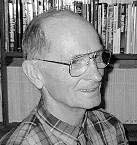
C.R. (Buzz) Nixon
A Former Head of the Cabinet briefing room and, later, Deputy Minister of National Defence for a decade, Buzz urges us to examine how the world arrived at its present predicament, and to initiate some of the more obvious material and behavioural changes that have to be made if there is to be any hope of the survival of civilized life beyond the middle of the century. His papers (see Annex 3) published in the CACOR Proceedings in the last two decades merit much wider circulation.
Since the Club of Rome itself became more highly organized there has been a move towards the regimentation of the National Associations as subsidiary bodies or “chapters” of the Club itself. Such a concept would have been repugnant to Aurelio Peccei. It remains to be seen how it will develop.
Another way of fulfilling the objectives of CACOR was the introduction of regular Luncheon Meetings with distinguished speakers on relevant topics. These were started on the initiative of Dr. Ed Napke who has continued to organize the remarkably popular series for many years. Still President of CACOR in 2005, Ed was first elected to the post in 1997.
Under Ed’s Chairmanship the Board of CACOR has sponsored a Global Systems Study developed by Robbert Associates, to which Rob Hoffman and a select group of CACOR members have devoted a great deal of time. Many presentations have been made, particularly to educational institutions and the software is in use for educational purposes in several places, including Australia.
Aurelio Peccei’s initiatives on the international scene were by no means confined to the Club of Rome and CACOR. He was a catalyst in the creation of at least three other important international institutions. I was deeply involved in the creation of two of them.
Several years ago representatives of the US, the USSR and the UK met to discuss the possibility of creating an institute to develop the techniques of systems analysis suitable for application to major current world problems. These talks were catalyzed, like those in the Club of Rome, by the personal efforts of Aurelio Peccei who was not later visibly associated with the initiative. The individuals concerned were Lord Zuckerman, then Chief Science Advisor to the Cabinet of the UK, McGeorge Bundy of the US and Dr. Djerman Gvishiani, Vice-Chairman of the State Committee on Science and Technology of the USSR, who had been present at that historic meeting of the Club of Rome Executive in the Palais Palaviccini in Vienna in 1969.
It was decided to invite the participation of some other countries and, as the initiative developed, this number increased. In October 1972 the representatives of 12 countries met in the offices of the Royal Society of London under the Chairmanship of Lord (“Solly”) Zuckerman. Solly was a friend of F.P. Bowden (with whom I had worked in Cambridge in the ’40s) and I had met him with Bowden during my stint in Cambridge. The so-called ‘plenary’ meeting was a tricky one. Zuckerman was careful not to define what it was a plenary meeting of. It could not be governments because some of the countries represented (such as East and West Germany) did not have diplomatic relations with each other. So we all were there as representatives of real or imaginary “non-governmental” organizations in our respective countries. In the case of the USA and the USSR it was the respective Academies of Science. In the case of Canada, Japan and some others it was a national “Committee for the Institute of Applied Systems Analysis”.
The charter of IIASA was signed after only one and one half days’ discussion. I was privileged to represent Canada at that plenary session and the Charter of IIASA carries my signature. Dr. Djerman Gvishiani was elected as the first Chairman of the Council and Howard Raiffa was appointed Director of the Institute. This was no mean achievement in a space of 36 hours when you consider the diverse nature of the countries involved the USSR, Canada, the USA, the UK, Japan, East and West Germany, France Italy, Poland, Czechoslavakia and Bulgaria. Austria and several other countries have joined since that time.
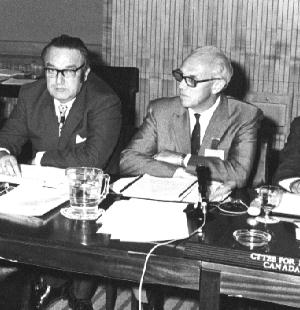
At the Plenary Session in the Offices of the Royal
Society, October 1972
(A Bulgarian Delegate on my right)
It was agreed, initially, that the USSR and USA Members would finance one-third of the operation each and the other countries would divide the remaining third between them. Our share was about a quarter of a million dollars for the first year. I “had it in my pocket” due to remarkable cooperation from my Minister, Alastair Gillespie, and the Canadian Ambassador in London at the time, Jake Warren, both of whom stuck their necks out in a worthy cause. Years later, Alastair Gillespie told the story at a luncheon of how I had persuaded him, the first and newly appointed Minister of State for Science and Technology, to “spend half my budget on supporting a research establishment in a village in Austria”. (The Austrian Government had offered to refurbish Schloss Laxenburg, near Vienna to accommodate the Institute.)
The “plenary” meeting agreed the initial conditions for creating this East-West research institute. The board of directors or Council of the Institute would consist of one representative from each of the member countries. It would have a Soviet Chairman and an American Vice-Chairman. The Director of the Institute would also be American. The plenary meeting appointed Djerman Gvishiani as Chairman, then dissolved and re-assembled as the Council of the Institute. Zuckerman’s job was ended, successfully, and Gvishiani took the chair.
The remarkable qualities of Gvishiani have never been better demonstrated than they were on that day. He started the first IIASA Council meeting by making a short statement in his excellent English. He said that, in his experience, more international initiatives had failed through linguistic arguments than from any other cause. He did not believe that the Institute could survive with more than one official language. The only feasible choice was English. So he was making the decision at the outset that English would be the official language of the Institute. Council business would take place in English and all documentation would appear in English. Of course, if any Member Organization wished to translate them for their own purposes they would be free to do so; but the official version would be the English one.
I recall no discussion of this remarkable statement. I think most of those present were momentarily stunned and, by the time they had recovered, Gvishiani was on the first item of the Agenda proper. However, on his first intervention the Soviet member started in the Russian language. Gvishiani let him get one sentence out before he interrupted him, saying, “Professor ———, you heard what I said; I know you have some difficulty with English but please try.” The Soviet member complied, albeit in bad grace. A little later the French member, Professor Lévy, spoke. Gvishiani cut him off after the first couple of words by saying in a light and humorous manner, “Professor Lévy: if the Russians can speak English, surely you can.” It was several years before anyone questioned the exclusive use of English again.
The first IIASA Council Member from the USA was none other than Harrison Brown, who had written Challenge to Man’s Future (loc cit) almost 20 years earlier. As a signatory of the Charter, I became a Council member and the first Chairman of the Canadian Committee for IIASA and served in both capacities for several years. The Canadian Committee consisted of about ten individuals drawn from the universities, industry and government. A notable member was Michael Kirby (now a Senator) who, after several years, succeeded me as Chairman of the Canadian Committee and Member of the IIASA Council.
IIASA was indeed eventually housed in the main buildings of a restored and refurbished Schloss Laxenburg.
The estate was situated in the middle of the tiny village of Laxenburg. It had not been occupied since World War I and was in pretty fair disrepair. The ground floor rooms had been used as stables and were covered with straw. Visiting Vienna for successive meetings, we watched the renovations progress until one day we were able to hold our meetings there. The government of Austria had spent about 10 million dollars on the renovations, meticulously replacing all the gold leaf trim and, as nearly as possible the original wall coverings. On behalf of Canada, I had occasion to present the Institute with a large chunk of 3-billion-year old conglomerate from the Canadian shield. It sits in a plastic case in a corridor of the Schloss as a token of the continuity of the planet. Perhaps, in retrospect that was a mistake, because that chunk of rock says nothing about the durability of civilized life on the planet, which is now in grave jeopardy.
IIASA, under the direction of Prof. Howard Raiffa, formerly of Harvard, set out to spend about half its resources developing the techniques of applied systems analysis and the other half applying them to regional and global problems. It has continued to support a mixture of theoretical and applied analysis and research. IIASA has 16 member countries in the year 2004, of which 5 are in former Warsaw Pact countries. The Institute differs considerably in nature from the Club of Rome. It is a research institute which exists by multi-national (albeit non-governmental) agreement and commands significant financial resources. Nevertheless its work is complementary to that of the Club of Rome.
IIASA is one of the few successful examples of East-West collaboration and a unique reminder of Aurelio Peccei’s catalytic powers. One of IIASA’s spectacular successes has been its study of the global energy situation, by a group led by Dr. Wolf Häfele, formerly head of a German nuclear research establishment. The IIASA publication Energy in a Finite World (IIASA, 1980) is, probably one of the most comprehensive and authoritative works to date on the future prospects for global energy.
That first Council of IIASA, of which I was a member, was a very friendly and effective body. It included Gvishiani as Chairman, Harrison Brown as Vice-chairman and Howard Raiffa, ex-officio, as Director of the Institute. It was our custom to hold an IIASA party every year for the staff of the Institute. It was usually held in the great hall of the vineyard of Gumpelskirchen, not far from Laxenburg. We would sit around the plain deal tables, with log fires burning in the hearths and drink the local wine with roast chicken.
Gvishiani showed his virtuosity even further at one of these events. A couple of musicians were strolling between the tables to entertain the group. One played the violin and the other the piano accordion. I happened to be seated next to Gvishiani when he beckoned the musicians over and entered into a long discussion with them. As a result, the accordion was handed over to Gvishiani and the violin to the young Englishman beside him who was the financial officer of IIASA. The young man was a good violinist but protested that he was not used to playing popular tunes. Despite the protestations, Gvishiani led off with a flourish to play brilliantly a number of well-known American and English catchy tunes and the violinist soon got into the hang of it. Soon Gvishiani was leading into characteristic tunes of most of the member countries, including Austria, thus showing an extraordinary versatility and virtuosity. The two of them played much better than the owners of the instruments, who applauded them loudly and sincerely. At the end he quietly handed the instruments back and reverted to his normal, rather shy personality.
I had known something of Gvishiani’s virtuosity before. At a Council party at Howard Raiffa’s, soon after the formation of IIASA, Harrison Brown sat at the piano and rattled off some American jazz tunes with moderate competence. A little while afterwards, Gvishiani moved to the piano stool and played some more jazz tunes with considerable flair.
Everyone was alerted to the fact that here was an unusual talent. As we listened the music changed, with great subtlety to take the style of Chopin, then Mozart, while still retaining the American theme. Then it moved to Mozart melodies with a touch of American Jazz styling. And it ended by a brilliant rendition of a purely classical piece.
At that time I had asked Gvishiani about his musical education. He said he had none – he couldn’t read a note. However, he had become curious about the techniques of playing musical instruments and had taught himself to play practically every instrument in the orchestra – by ear. It was a remarkable ear!
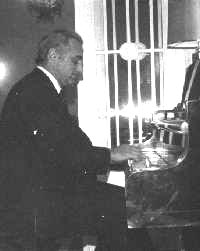
Djerman Gvishiani improvising at the piano in Howard Raiffa’s home in Vienna
Another important institutional offshoot of the activities of Aurelio Peccei, Alex King and some colleagues in the Club of Rome is the International Federation of Institutes of Advanced Study (IFIAS), of which Alex King was the first Chairman. Aurelio Peccei was a Director of IFIAS until the time of his death in 1984. The purpose of this institution is to stimulate the very considerable talent associated with the institutes of advanced study that exist in many countries to address urgent, global problems, rather than pursue exclusively academic studies. IFIAS finds the resources to create multi-national teams to address selected problems. The problem of the drought in the Sahel is one of many to which IFIAS has applied its research resources.
The young King Carl XVI Gustaf of Sweden took such an interest in IFIAS that he granted it the use of the Palace of Ülriksdal, near Stockholm, where the Federation had its headquarters.
Thanks to the influence of Aurelio Peccei and Alex King, IFIAS was able to mobilize many of the best intellects in the world to address problems that might succumb to the scientific approach. After Alex King retired as Chairman, the Institute moved its headquarters to Toronto under the Chairmanship of a Canadian, Dr. Ian Burton.
Still another significant institutional innovation that was catalyzed by Club of Rome members and Aurelio Peccei is the Foundation for International Training (FIT). This Toronto-based non-profit organization harnesses the efforts of a large number of capable individuals to provide on-the-spot, low-cost technical and management training in developing countries. The training is given, as far as possible, to local individuals who will themselves act as the centre of training for others. Dr. Alexander King is Chairman of the Board of the Foundation, on which I served for many years. Aurelio Peccei was also a Director up to the time of his death and provided great encouragement to the Executive Director of the Institute, Ranjit Kumar, around whose talents the Institute was created. FIT, which has received substantial support from the Canadian International Development Agency (CIDA) and other aid organizations, is now collaborating with the Australian equivalent of CIDA to provide training in the Pacific region.
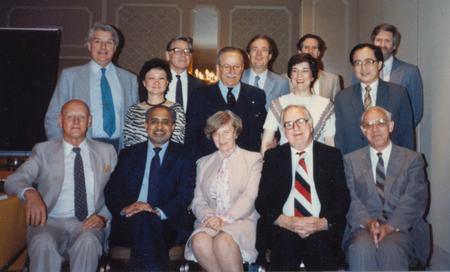
The first Board of Directors of FIT
(Front row: John Stokes, Ranjit Kumar, Bea Bazar(Chair),
Alex King and the Author)
In spite of all these initiatives, there seems to have been little progress towards breaking the political impasse which paralyses national and international action against global threats. In the meantime the global predicament intensifies and become at once more difficult and more costly to address. I am afraid that it becomes less and less likely that it ever will be faced in time to prevent irreversible chaos and the collapse of civilization. Those of you who may find that too strong a statement should reflect that your reaction may simply underscore the success of the world’s politicians and media in promoting the ostrich approach to the dangers ahead.
